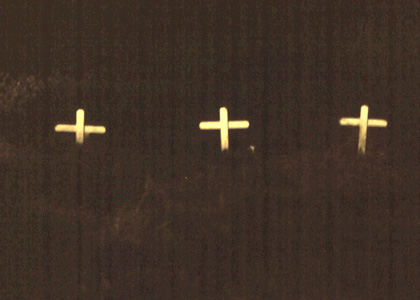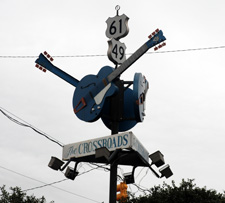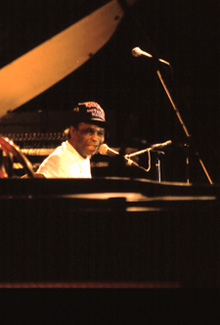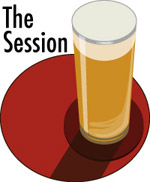
beernews.org reports that Dogfish Head Craft Brewery and Sony Legacy are set to collaborate on another beer/music project, this time turning to the blues.
In mid-January, Sony Music Entertainment filed a trademark application for Robert Johnson’s Hellhound on my Ale. The name is a play on words from one of Johnson’s songs, Hellhound on my Trail. This week, Dogfish got TTB approval for a keg collar. The only description available is that it’s brewed with lemons.
Enough about beer. On to Robert Johnson. Here’s what Sony Legacy wants you to know about him: “May 8, 2011, marks the 100th birthday of Mississippi Delta bluesman Robert Johnson, who, according to legend, sold his soul down at the crossroads of Highway 61 and Highway 49 in a midnight bargain that has haunted the music world for three-quarters of a century. The ‘deal’ brought forth Johnson’s incandescent guitar technique and a run of 10-inch 78 rpm singles for the Vocalion, Oriole, Conqueror and Perfect labels recorded in San Antonio in 1936 and Dallas in 1937.” Sony then gets to the point. It’s selling two special Robert Johnson sets.
 Since we’re pretty sure that Johnson didn’t actually enter in a transaction with the devil it might seem silly to worry about the location of THE crossroads themselves, but humor me. It wasn’t necessarily, or even probably, where Highway 61 and Highway 49 meet.
Since we’re pretty sure that Johnson didn’t actually enter in a transaction with the devil it might seem silly to worry about the location of THE crossroads themselves, but humor me. It wasn’t necessarily, or even probably, where Highway 61 and Highway 49 meet.
More than twenty years ago Living Blues magazine devoted pretty much an entire issue to “The death of Robert Johnson.” Jim O’Neal set the tone with his introduction.
As marvelous and influential as Robert Johnson was, his life, lyrics, and legend have still received an inordinate amount of attention over the past 20 or 30 years. The mythic proportions of the Johnson legend are largely the product of modern-day audiences’ and writers’ enthusiasm (further fueled by this issue of Living Blues, of course). The search for anything of substance pertaining to Johnson has produced a valuable body of research, but it has also created more and more pitfalls where fiction may bury the facts.
Almost every blues artist of Johnson’s generation who has been interviewed has probably been asked about Robert Johnson (sometimes ad nauseam), and who knows how many times one bluesman or another has fabricated a tale merely to prey on a young interviewer’s anthusiams and keep his attention a little longer.
 Honeyboy Edwards, who’ll be 96 years old in June, tells a convincing story in that 1990 Living Blues about playing with Johnson the night he was poisoned. By a bit of chance we heard him repeat it in 1992 at a Clarksdale, Mississippi, lunch spot called Fair’s. He was in town to enjoy the Sunflower Blues Festival. The week before he performed at the first — there might have one or two more — Robert Johnson Crossroads Festival in nearby Greenwood (the photo on the right). Anyway, if I were in charge of organizing a Robert Johnson commemorative beer I’d invite Honeyboy to toss in a few hops.
Honeyboy Edwards, who’ll be 96 years old in June, tells a convincing story in that 1990 Living Blues about playing with Johnson the night he was poisoned. By a bit of chance we heard him repeat it in 1992 at a Clarksdale, Mississippi, lunch spot called Fair’s. He was in town to enjoy the Sunflower Blues Festival. The week before he performed at the first — there might have one or two more — Robert Johnson Crossroads Festival in nearby Greenwood (the photo on the right). Anyway, if I were in charge of organizing a Robert Johnson commemorative beer I’d invite Honeyboy to toss in a few hops.
To return to beer for a moment, apparently they wouldn’t want to call this new one Crossroads because Anheuser-Busch briefly tested a wheat beer by that name in 1995. Flunked the test; guess there was no deal with the devil.
Back to Robert Johnson. We made two trips into the Mississippi Delta in 1992, because Daria was writing a story for Touring America called “Where the Blues Began.” We used Living Blues to help us find historically important spots. O’Neal wrote an article called “A Traveler’s Guides to the Crossroads” that even had maps, and was still properly skeptical.
I have never heard any musician claim to have made any deal at any crossroads, by the way, although some say they have heard such stories told by old-timers. But Napoloan Strickland of Como, Mississippi, did tell me that, following instructions from his grandfather, he learned to play music by going to a cemetery and ‘straddling a grave” at midnight.
One of the crossroads mentioned was near Bonnie Blue Plantation, where Johnson lived, and White Cemetery. We headed there near dark, per O’Neal’s suggestion. I’m not sure we actually found the right cemetery, but we did spy three crosses, shined the car headlights on them and I took the photo at the top. The experience became the lead to Daria’s story.
“You’re standing in a tiny cemetery that’s surrounded by a cotton field. The few stark white crosses rise from the grass like ghosts. Across the dirt road in one direction is a field of tall corn, in the other, a field of sorghum. It’s growing dark, and you realize that if you screamed your loudest, no one would come.
“This could be the place, you think — the crossroads where blues musician Robert Johnson claimed he met the Devil. Here, the idea doesn’t seem so far fetched. You can easily imagine a thin young man with a guitar slung over his shoulder making his way down the road, and a dark stranger appearing suddenly from out of the corn.”
It’s going to take a spectacular beer to stand up to that memory.
 Don’t forget The Session #49 on Friday, when
Don’t forget The Session #49 on Friday, when